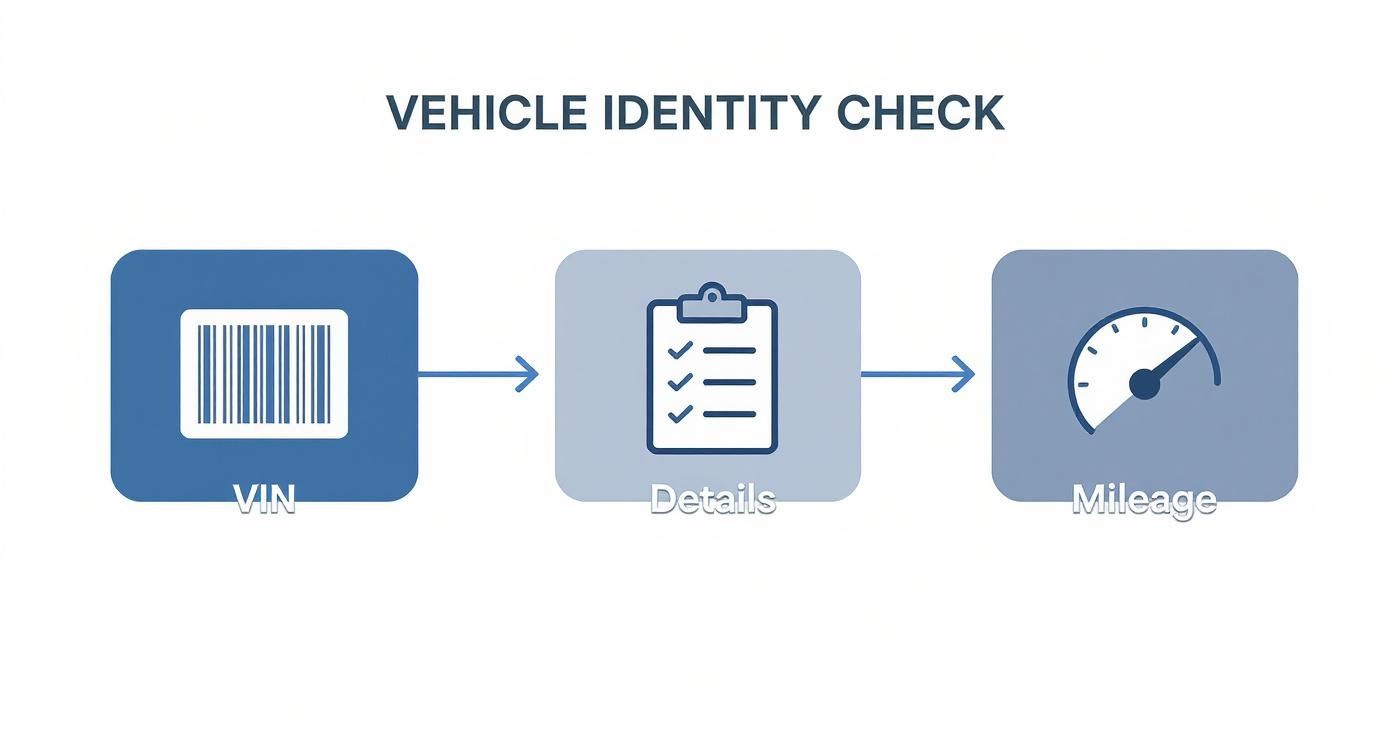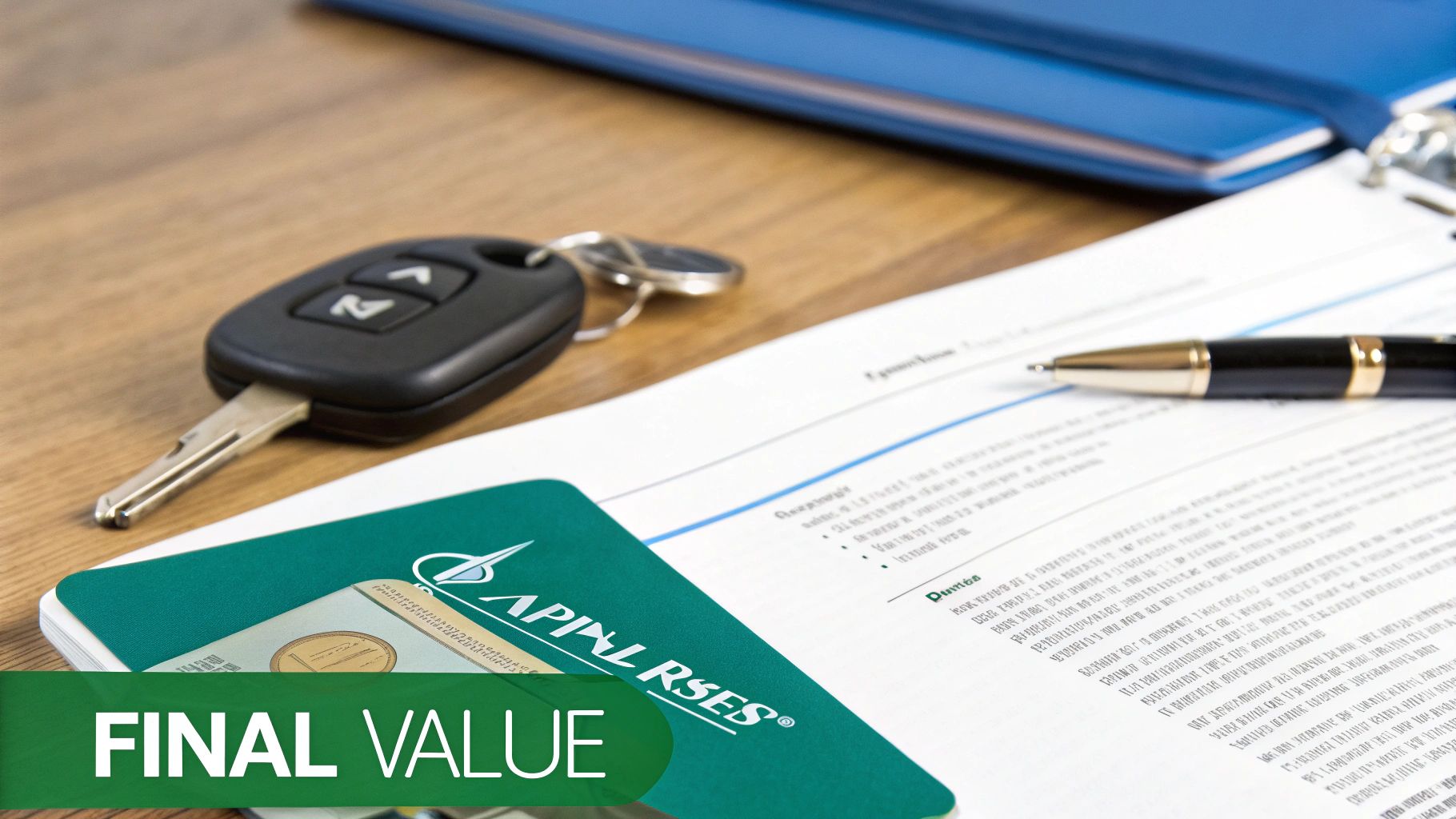When you get a car appraisal report after an accident, it can look like it was written in another language. It’s often packed with jargon, tables, and fine print that feels intentionally confusing.
But buried in that document is everything you need to get a fair payout for your car, whether you’re filing a diminished value claim or dealing with an insurance total loss payout. This guide will show you exactly how to read an appraisal report and use it to your advantage.
Turning Confusion Into Confidence: Your Guide to the Appraisal Report

This guide is your roadmap. We’re going to walk through the report section by section, showing you what actually matters and what’s just noise. The goal is simple: to give you the confidence to read it, understand it, and use it to strengthen your claim.
What You’ll Learn in This Guide
By the time you’re done here, you’ll know how to:
- Pinpoint the important stuff: Instantly find the final valuation and the evidence backing it up.
- Spot the red flags: Recognize common insurer tactics used to undervalue claims, like cherry-picking bad “comparable” vehicles.
- Understand key terms: Know what Fair Market Value (the price your car would have sold for before the accident) and Diminished Value (the loss in resale value after repairs) really mean.
- Negotiate with facts: Walk into a conversation with an adjuster armed with certified data, not just feelings.
Let’s dive in and start decoding your report.
How to Read an Appraisal Report: The Key Sections
To give you a quick overview, here are the core parts of an appraisal report you absolutely need to understand.
Key Sections of Your Appraisal Report at a Glance
This table breaks down the most important sections of a vehicle appraisal report and explains why each one is so critical for your claim.
| Section Name | What It Tells You | Why It’s Critical for Your Claim |
|---|---|---|
| Vehicle Identification & Condition | Confirms your car’s specific details—VIN, mileage, options, and pre-accident condition. | Accuracy here is non-negotiable. Wrong info can lead to a completely incorrect valuation. |
| Market Area & Comparable Vehicles | Lists similar vehicles (“comps”) used to determine your car’s pre-accident market value. | This is where many insurers undervalue claims. Weak or irrelevant comps will sink your settlement amount. |
| Valuation Methodology | Explains the formula or approach the appraiser used to arrive at their final number (e.g., sales comparison, cost approach). | Understanding the how helps you challenge the what. If the method is flawed, the result is flawed. |
| Adjustments & Deductions | Details any additions or subtractions made to the base value for things like mileage, condition, or prior damage. | These adjustments can be subjective. You need to verify they are fair and not just excuses to lower the payout. |
| Final Value Conclusion | The appraiser’s official opinion of your vehicle’s Fair Market Value or Diminished Value. | This is the bottom-line number your entire claim is built on. Every other section is there to support this figure. |
Think of these sections as the building blocks of your claim. If any one of them is weak or inaccurate, the whole thing can fall apart. Now, let’s break down each one so you know exactly what to look for.
Getting the Basics Right: Vehicle Identity and Condition
The first few pages of any appraisal report are where the entire valuation gets its start. Think of it as your vehicle’s official ID—if the details are off here, the final number will be, too. Getting this part perfect is non-negotiable.
Your first job is to confirm the report identifies your exact car. Pull out your registration or sales documents and check the Vehicle Identification Number (VIN), make, model, year, and trim level line by line. A simple mix-up, like listing a base model instead of the premium trim you actually own, can torpedo your vehicle’s value from the get-go. Learn more on how to review auto appraisal report.
Pre-Accident Condition and Mileage
Once you’ve confirmed the basics, zoom in on how the appraiser documented your car’s condition before the accident. This is the baseline value, the starting point for everything that follows.
You should see a detailed breakdown that includes:
- Mileage: Is the odometer reading accurate for the date of the loss?
- Options & Packages: Did they list every single factory-installed feature? Things like a sunroof, premium sound system, or an advanced safety package are easily missed by insurers.
- Custom Upgrades: What about aftermarket additions? If you added custom wheels or an upgraded exhaust, they need to be noted.
- Overall Condition: The appraiser will assign a rating like Excellent, Good, or Fair. Make sure it honestly reflects how well you maintained your car before the crash.
Key Takeaway: Your goal is to make sure the appraisal starts from a flawless, accurate baseline. Scrutinize every detail in this section. An error here will ripple through every other calculation, guaranteeing a flawed result.
Looking Closer at the Market Analysis and Comparables
This part of the report is where the rubber meets the road. It’s the section where the appraiser lays out their case for the final valuation by analyzing recent sales of similar vehicles, often called comparables or “comps.”
Make no mistake, the quality of these comps is everything. A fair valuation lives or dies by the strength and relevance of these examples.
A credible report will only use comps that are truly like your vehicle. This means they need to match up in the most important ways—mileage, overall condition, features, and critically, geographic location. A car sold 500 miles away isn’t a valid comparison because local markets can be wildly different.
Before an appraiser even gets to the comps, they first have to lock down the vehicle’s identity. The graphic below shows the basic data points they verify.

Getting these fundamental details right is the first step. Without it, any market analysis or comparable selection that follows is built on a shaky foundation.
What Makes for a Strong Comp?
When you’re reviewing this section, you’re essentially playing detective and fact-checking the appraiser’s evidence. A solid, defensible report will give you a clear, logical reason for its final number.
For each comparable vehicle listed, you need to zero in on these elements:
- Geographic Proximity: Comps absolutely must come from your immediate market area. If an insurer is pulling comps from other states, it’s a huge red flag.
- Similar Mileage and Condition: A comp with 50,000 more miles or one listed in “fair” condition has no business being compared to your well-maintained, low-mileage car without some serious adjustments.
- Matching Trim and Options: The report should be an apples-to-apples comparison. A base model is not a fair comp for a fully loaded one, period.
Spotting Unfair Adjustments and Other Red Flags
Appraisers will make “adjustments” to a comp’s price to account for any differences. For instance, if a comparable vehicle has higher mileage than yours, the appraiser should adjust its value upward to reflect the difference.
You need to scrutinize these adjustments. Do they make sense? Are they clearly explained? This is often where insurers try to sneak things by.
Key Takeaway: An insurer’s report packed with distant, high-mileage, or beat-up comps isn’t an accident. It’s often a deliberate tactic to justify a lowball offer. Your independent appraisal should be ready to counter this with strong, local, and truly comparable vehicles.
At the end of the day, market analysis is the backbone of any appraisal worth its salt. The best appraisers don’t just pick a few cars; they use broad statistical data to add weight and context to their conclusions. If you really want to see what goes into a professional-grade report, you can explore courses from the International Society of Appraisers to understand the standards they follow.
Curious about where your own vehicle stands in today’s market? A good first step is learning how much your car is worth to get an initial estimate.
How We Figure Out Your Car’s Value
Ever wonder how an appraiser turns a mountain of data into a single, concrete number? It’s not just guesswork. This part of the report pulls back the curtain to show you the exact methods we use to determine your vehicle’s true worth.
When it comes to vehicle appraisals, the most reliable and widely accepted method is the Sales Comparison Approach. The idea is simple: the best way to know what your car is worth is to see what similar cars have recently sold for right in your local area. It’s the industry gold standard because it’s based on real transactions, not just theories.
The Logic Behind the Numbers
Sure, other methods exist, like the Cost Approach (what it would cost to build a replacement from scratch), but the Sales Comparison Approach gives us the most accurate picture of your car’s fair market value. That’s the price a ready buyer would willingly pay a ready seller, with neither being under pressure.
Modern appraisals are incredibly data-driven. In fact, the global real estate appraisal market hit around $12.3 billion in 2023, which gives you an idea of how much analysis goes into this work. In your report, you’ll see how the appraiser blends broad market data with the specific details of your car, lining it up against at least three to five comparable vehicles, or “comps.”
For a deeper look into the market, you can find more insights on the global appraisal service market from DataIntelo.
Turning Raw Data into a Defensible Value
The final step is what we call reconciliation. This isn’t just about averaging the prices of the comparable cars. It’s where the appraiser’s expertise really comes into play. They carefully weigh all the evidence, giving more significance to the comps that are the closest match to your vehicle.
Key Takeaway: Reconciliation is where the magic happens. The appraiser analyzes everything—the quality of the comps, the value adjustments, and current market trends—to arrive at one final, solid opinion of value.
That final number you see isn’t pulled out of thin air. It’s a conclusion built on a foundation of hard market evidence, designed to be defensible and stand up to scrutiny from any insurance company.
Finding the Final Value and Appraiser’s Certification
Alright, let’s get to the good stuff. The last few pages of your appraisal report are where you find the numbers that will drive your entire insurance negotiation. This section holds the bottom line and the proof that makes it all credible.

You’ll want to look for a heading like “Final Opinion of Value” or “Reconciliation.” This is it—the appraiser’s official conclusion. It will state either the Fair Market Value (for a total loss) or the exact dollar amount of your car’s Diminished Value. Every part of your claim is built on this single number.
The Power of the Appraiser’s Certification
Just as important as the final value is the Appraiser’s Certification. Don’t just skim this part thinking it’s fine print. It’s actually a sworn statement that turns the report from a simple opinion into hard, defensible evidence.
The certification is the appraiser’s promise that they:
- Are completely unbiased and have no personal or financial stake in your claim’s outcome.
- Followed strict professional standards, like the Uniform Standards of Professional Appraisal Practice (USPAP).
- Built their conclusion on a logical analysis of real, verifiable market data.
Modern appraisals aren’t just guesswork; they rely heavily on high-quality data. In fact, by 2024, the industry had widely adopted big data analytics to dial in precision—a trend expected to fuel market growth. A proper certification proves the appraiser used these reliable methods to arrive at their number.
Key Takeaway: The appraiser’s certification is your proof that the valuation is objective, professional, and built on facts. It’s what you hand an adjuster to show your claim is backed by a certified, unbiased expert—not just what you think your car is worth.
This powerful one-two punch of a final value and a professional certification gives you the leverage you need to get paid fairly. For more details, check out our complete guide on getting a car appraisal after an accident.
Frequently Asked Questions About Appraisal Reports
What if the insurance company’s appraisal is much lower than mine?
This happens all the time, so don’t panic. Your first move is to send your independent report to the adjuster. Politely but firmly explain that their offer doesn’t reflect your vehicle’s actual market value, and that your certified report provides a more accurate valuation backed by solid, local evidence. Be prepared to point out specific flaws in their report, like irrelevant comparable vehicles.
Can I claim diminished value if the accident wasn’t my fault?
What if the insurance company’s appraisal is much lower than mine?
This happens all the time, so don’t panic. Your first move is to send your independent report to the adjuster. Politely but firmly explain that their offer doesn’t reflect your vehicle’s actual market value, and that your certified report provides a more accurate valuation backed by solid, local evidence. Be prepared to point out specific flaws in their report, like irrelevant comparable vehicles.
What does it mean for a report to be USPAP compliant?
USPAP stands for the Uniform Standards of Professional Appraisal Practice. Think of it as the official rulebook for professional appraisers. When a report is USPAP compliant, it means the appraiser followed nationally recognized standards for objectivity and methodology. This gives the report serious legal weight, making it much harder for an insurance company to dismiss your claim.
Why do I need an independent appraisal report?
Insurance companies are businesses, and their goal is to pay out as little as possible. Their appraisers often use reports from providers like CCC ONE that are known to use methodology that favors the insurer. An independent appraisal from a certified expert like SnapClaim provides unbiased, data-backed proof of your car’s true value, leveling the playing field so you can negotiate fairly.
Ready to fight for a fair settlement? SnapClaim provides the certified, data-backed appraisal reports you need to strengthen your insurance claim. We’re so confident in our reports that we offer a Money-Back Guarantee: if your insurance recovery from the claim is less than $1,000, SnapClaim refunds the full appraisal fee.
About SnapClaim
SnapClaim is a premier provider of expert diminished value and total loss appraisals. Our mission is to equip vehicle owners with clear, data-driven evidence to recover the full financial loss after an accident. Using advanced market analysis and industry expertise, we deliver accurate, defensible reports that help you negotiate confidently with insurance companies.
With a strong commitment to transparency and customer success, SnapClaim streamlines the claim process so you receive the compensation you rightfully deserve. Thousands of reports have been delivered to vehicle owners and law firms nationwide, with an average of $6,000+ in additional recovery per claim.
Why Trust This Guide
This guide was reviewed and verified by SnapClaim’s auto appraisers, who specialize in diminished value and total loss disputes.
Our team continually updates every article to reflect current insurer guidelines, valuation standards, and court-accepted appraisal practices, ensuring that you’re relying on information trusted by professionals nationwide.
Get Started Today
Whether you’re challenging a low total loss settlement or proving your vehicle’s post-repair loss in value, SnapClaim makes it simple to take the next step.
Generate a free diminished value or total loss estimate in minutes and see how much compensation you may be owed.


